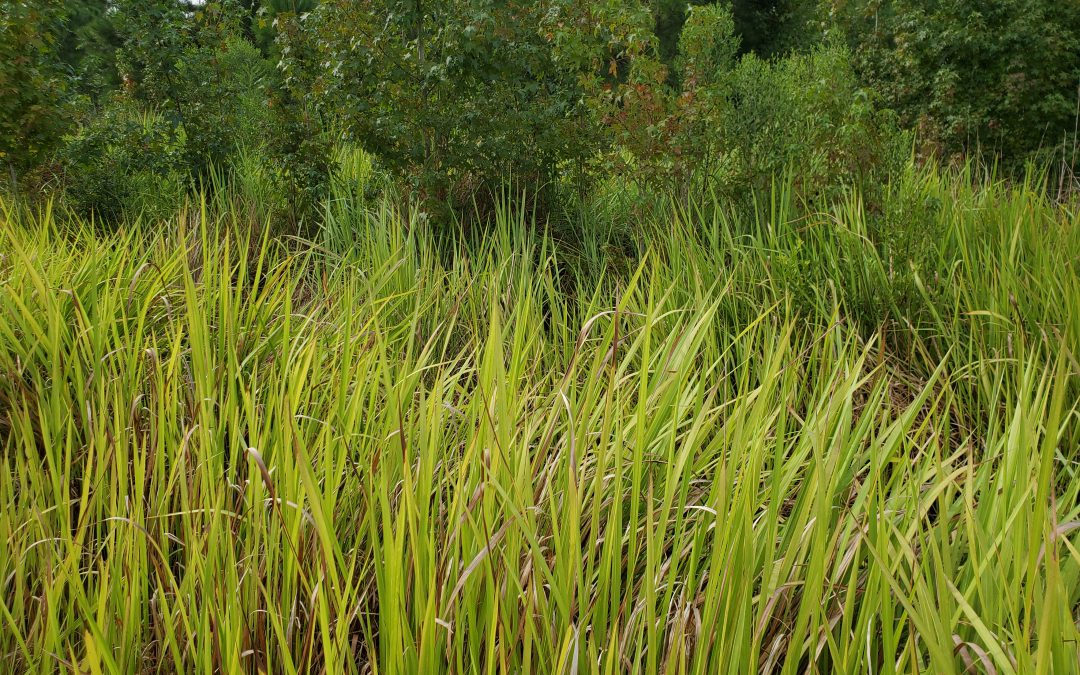
by Daniel J. Leonard | Oct 8, 2021
Over the last decade or so, the Panhandle has been overrun, and I don’t just mean by the summer beach traffic. Rather, by an aggressive, exotic perennial grass that quickly displaces all native species, is not useful as a forage to wildlife or livestock, can spread by roots or seeds, and has no natural enemies. If you own property in the Panhandle or spend any amount of time on its roads, chances are you have become acquainted with this worst of invasive species, Cogongrass (Imperata cylindrica).
A native of Southeast Asia, cogongrass was introduced into the US in 1912 around Mobile, AL as a hitchhiker in orange crate packing. Then the 1920s, 30s, and 40s, it was intentionally introduced from the Philippines into other Gulf Coast states, including Florida, as a potential pasture forage for livestock. Since then, cogongrass has become one of the most economically and ecologically important invasive species in the US and worldwide, infesting nearly 500 million acres and is now found on every continent.
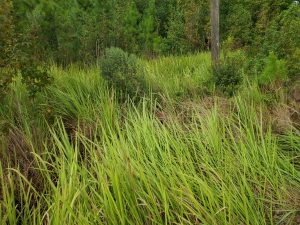
Cogongrass in Calhoun County, FL. Photo courtesy of Daniel Leonard.
Cogongrass is easily identified in late spring, when the grass throws easily spotted fluffy, white-colored seedheads above the mats of grass beneath. Additionally, patches of cogongrass are almost always noticeably circular in nature, radiating out indefinitely from the initial infestation. A closer inspection of the grass will reveal light green leaves up to 4’ in length, with an off-center, silvery colored midrib (the primary leaf vein that runs from the base of the leaf to the tip) and serrated leaf edges. Underground, cogongrass exhibits a dense underground root system that can reach as deep as 4’. This feature is the primary reason cogongrass outcompetes other plants, withstands any drought, fire, or soil condition thrown at it, aids in its resistance to herbicide activity, and generally makes it very difficult to manage.
The first step in managing cogongrass is prevention. If your property or the property you manage doesn’t have cogongrass, do everything you can to keep it that way. While the species can spread distances through seed dispersal, it is much more frequently moved around by fragmented rhizomes hitching a ride on equipment. If you or a contractor you’ve hired are working in or around an area with cogongrass present, avoid disturbing it with equipment and be diligent in monitoring the site for outbreaks following the job’s completion.
If you find cogongrass on your property, effectively eradicating it requires patience, persistence, and several years’ worth of herbicide applications. Currently, of the hundreds of herbicides available for purchase, only two chemistries have been proven to be very effective in destroying cogongrass, impazapyr (Arsenal, Stalker, etc.) and glyphosate (Roundup, Cornerstone, etc.).
- Imazapyr is an extremely effective non-selective, residual herbicide that controls a wide variety of weed species, including cogongrass. Just one or two applications of imazapyr can provide 18-24 months of effective cogongrass control, with follow up treatments required as needed after that. However, Imazapyr has a major downside that limits its use in many settings. Because it is a non-selective herbicide with significant soil residual activity, it cannot be used around the root zones of desirable plants. Oaks, other hardwood trees, and most landscape plants are especially sensitive to imazapyr. This herbicide is best limited to use in fields, waste/fallow areas, natural areas, and monoculture pine plantations – it is not appropriate in most residential and commercial landscapes.
- The other option, glyphosate is a non-selective herbicide with no soil residual activity. It is often a better option where severe injury or death of desirable hardwood trees and ornamental plants cannot be tolerated. However, due to its lack of residual soil activity, glyphosate applications on cogongrass patches will need to be repeated on an annual or biannual basis for up to five years for eradication of the infestation.
*Regardless of which herbicide you choose, controlling cogongrass is a multi-year affair requiring diligence and patience.
For more information on cogongrass and for specific herbicide recommendations and application rates/timing for your site, please contact your local UF/IFAS County Extension Office.
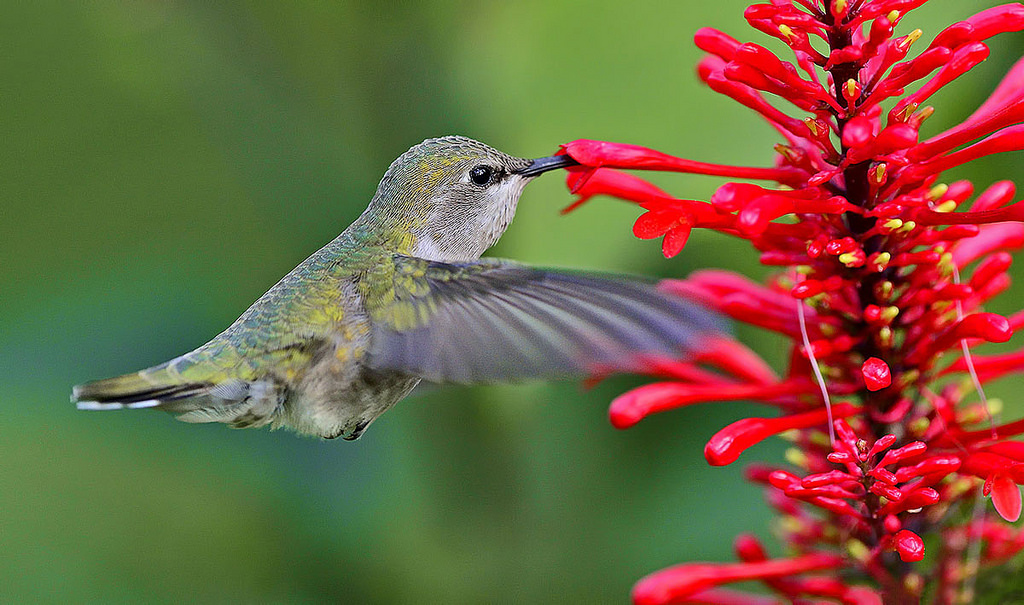
by Sheila Dunning | Oct 4, 2021
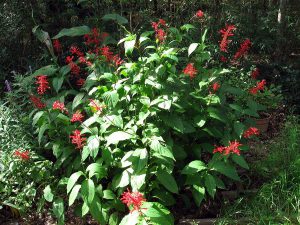 Looking to add something to brighten your landscape this autumn? Firespike (Odontonema strictum) is a prolific fall bloomer with red tubular flowers that are very popular with hummingbirds and butterflies. Its glossy dark green leaves make an attractive large plant that will grow quite well in dense shade to partial sunlight.
Looking to add something to brighten your landscape this autumn? Firespike (Odontonema strictum) is a prolific fall bloomer with red tubular flowers that are very popular with hummingbirds and butterflies. Its glossy dark green leaves make an attractive large plant that will grow quite well in dense shade to partial sunlight.
In frost-free areas firespike grows as an evergreen semi-woody shrub, spreads by underground sprouts and enlarging to form a thicket. In zones 8 and 9 it usually dies back to the ground in winter and re-sprouts in spring, producing strikingly beautiful 9-12 inch panicles of crimson flowers beginning at the end of summer and lasting into the winter each year.
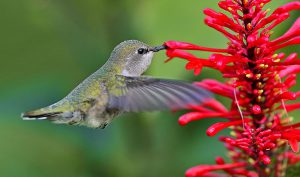 Firespike is native to open, semi-forested areas of Central America. It has escaped cultivation and become established in disturbed hammocks throughout peninsular Florida, but hasn’t presented an invasive problem. Here in the panhandle, firespike will remain a tender perennial for most locations. It can be grown on a wide range of moderately fertile, sandy soils and is quite drought tolerant. Firespike may be best utilized in the landscape in a mass planting. Plants can be spaced about 2 feet apart to fill in the area quickly. It is one of only a few flowering plants that give good, red color in a partially shaded site. The lovely flowers make firespike an excellent candidate for the cutting garden and is a “must-have” for southern butterfly and hummingbird gardens. Additional plants can be propagated from firespike by division or cuttings. However, white-tailed deer love firespike too, and will eat the leaves, so be prepared to fence it off from “Bambi”.
Firespike is native to open, semi-forested areas of Central America. It has escaped cultivation and become established in disturbed hammocks throughout peninsular Florida, but hasn’t presented an invasive problem. Here in the panhandle, firespike will remain a tender perennial for most locations. It can be grown on a wide range of moderately fertile, sandy soils and is quite drought tolerant. Firespike may be best utilized in the landscape in a mass planting. Plants can be spaced about 2 feet apart to fill in the area quickly. It is one of only a few flowering plants that give good, red color in a partially shaded site. The lovely flowers make firespike an excellent candidate for the cutting garden and is a “must-have” for southern butterfly and hummingbird gardens. Additional plants can be propagated from firespike by division or cuttings. However, white-tailed deer love firespike too, and will eat the leaves, so be prepared to fence it off from “Bambi”.
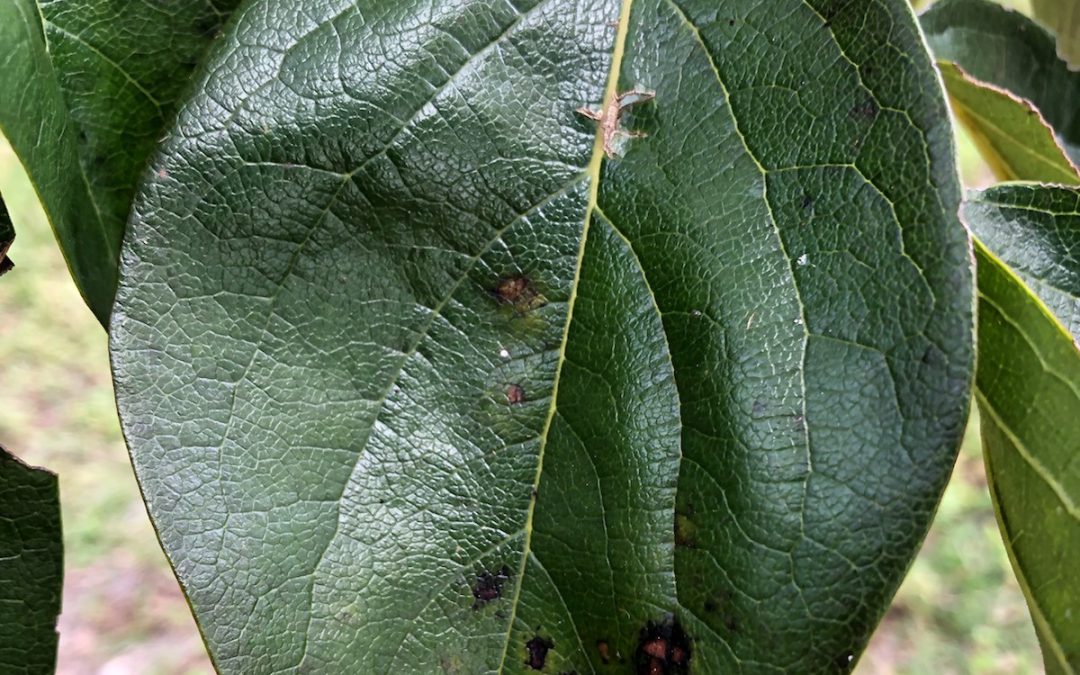
by Matthew Orwat | Oct 1, 2021
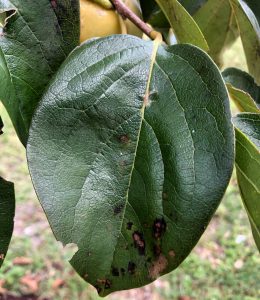
A spotted Japanese Persimmon leaf, Image Credit: Matthew Orwat
In gardening, brown or black spotted leaves are most often an indicator of disease problems or growth issues. This causes us to worry and seek answers as to why this is occurring. This is good since the first step in solving a plant growth or disease issue is diagnosis.
During Fall, the presence of brown or black spots on leaves of shade and fruit trees is usually not cause for alarm, as it might be in the spring or summer. Certain shade trees such as Southern Magnolia, Japanese Magnolia, various maple, persimmon and oak in the Red Oak group show substantial brown and black leaf spotting as Fall arrives. This is due to the fact that these leaves have been attacked by fungal pathogens and insects since Spring and resistance to damage has broken down over time. As Fall progresses, these leaves will senesce (purposeful deterioration due to age, such as at end of season) and fall to the ground. Therefore, this ugly spotting is part of natural seasonal leaf decomposition in deciduous trees.
Although Fall leaf spotting may not be something to worry about, oftentimes we run into plant problems that need quick diagnosis. Fortunately, your local Extension Office and the Plant Disease Diagnostic Clinic at NFREC exists for these situations. If you need help with plant problems, feel free to contact your local Extension Agent or Master Gardener Volunteer group and they will figure it out or send it along to the Diagnostic Clinic (small diagnostic fee if using NFREC clinic services).
If you happen to live in or near Washington County, we are launching our Second Mondays Free Plant Clinic. Staffed by knowledgeable and friendly UF / IFAS Master Gardener volunteers and your County Extension Agent, we will be available every second Monday of the month from 10am to 2pm at the Washington County Ag Center, which houses the UF / IFAS Extension Office. We will be located in the Master Gardener Volunteer Library which is just left of the central auditorium double doors. The launch date of this plant clinic is Monday, October 11th. See you then!
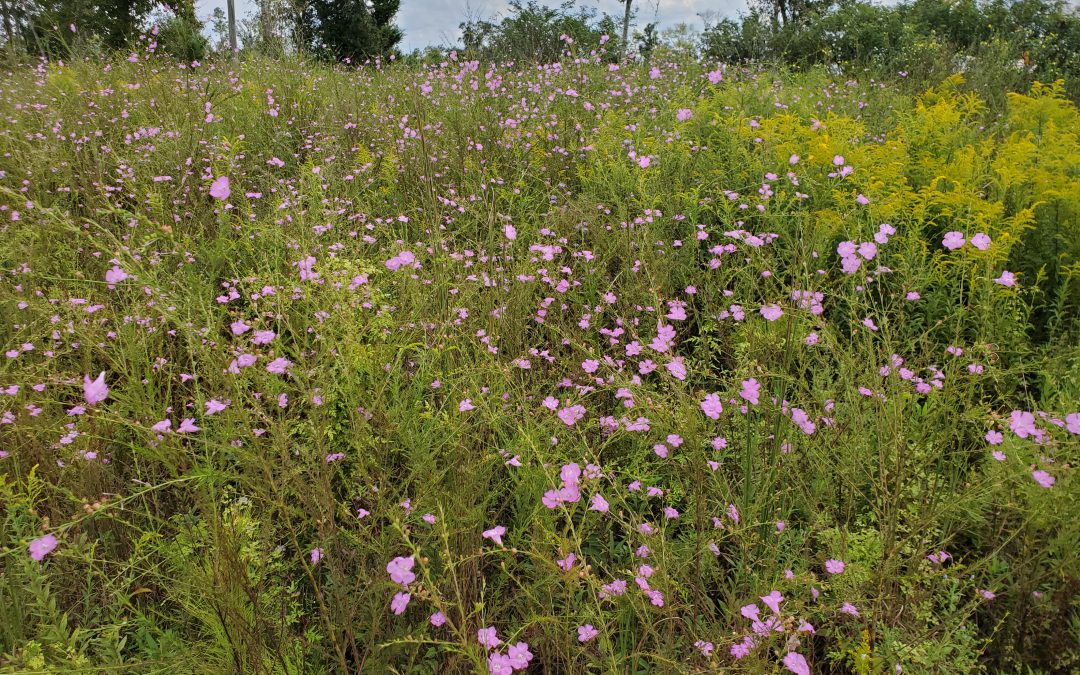
by Daniel J. Leonard | Sep 30, 2021
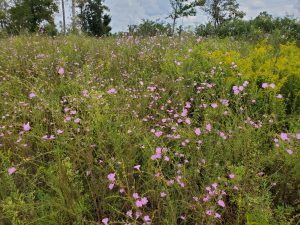
False Foxglove in a Calhoun County natural area. Photo courtesy of Daniel Leonard.
Fall is the absolute best season for wildflower watching in the Panhandle! When mid-September rolls around and the long days of summer finally shorten, giving way to drier air and cooler nights, northwest Florida experiences a wildflower color explosion. From the brilliant yellow of Swamp Sunflower and Goldenrod, to the soothing blue of Mistflower, and the white-on-gold of Spanish Needles, there is no shortage of sights to see from now until frost. But, in my opinion, the star of the fall show is the currently flowering False Foxglove (Agalinus spp.).
Named for the appearance of their brilliant pink flowers, which bear a resemblance to the northern favorite Foxglove (Digitalis spp.), “False Foxglove” is actually the common name of several closely related species of parasitic plants in the genus Agalinus that are difficult to distinguish by all but the keenest of botanists. Regardless of which species you may see, False Foxglove is an unusual and important Florida native plant. Emerging from seed each spring in the Panhandle, plants grow quickly through the summer to a mature height of 3-5’. During this time, False Foxglove is about as inconspicuous a plant as grows. Consisting of a wispy thin woody stem with very small, narrow leaves, plants remain hidden in the flatwoods and sand hill landscapes that they inhabit. However, when those aforementioned shorter September days arrive, False Foxglove explodes into flower sporting sprays of dozens of light purple to pink tubular-shaped flowers that remain until frost ends the season.
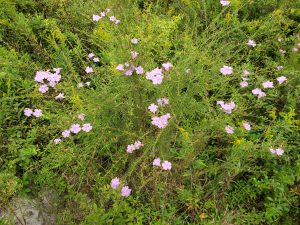
False Foxglove flowering in a Calhoun County natural area. Photo courtesy of Daniel Leonard.
In addition to being unmatched in flower, False Foxglove also plays several important ecological roles in Florida’s natural areas. First, False Foxglove’s relatively large, tubular-shaped flowers are the preferred nectar sources for the larger-sized native solitary and bumble bees present in the Panhandle, though all manner of generalist bees and butterflies will also visit for a quick sip. Second, False Foxglove is the primary host plant for the unique Common Buckeye butterfly. One of the most easily recognizable butterflies due to the large “eye” spots on their wings, Common Buckeye larvae (caterpillars), feed on False Foxglove foliage during the summer before emerging as adults and adding to the fall spectacle. Finally, False Foxglove is an important indicator of a healthy native ecosystem. As a parasitic plant, False Foxglove obtains nutrients and energy by photosynthesis AND by using specialized roots to tap into the roots of nearby suitable hosts (native grasses and other plants). As both False Foxglove and its parasitic host plants prefer to grow in the sunny, fire-exposed pine flatwoods and sand ridges that characterized pre-settlement Florida, you can be fairly confident that if you see a natural area with an abundance of False Foxglove in flower, that spot is in good ecological shape!
The Florida Panhandle is nearly unmatched in its fall wildflower diversity and False Foxglove plays a critical part in the show. From its stunning flowers to its important ecological roles, one would be hard-pressed to find a more unique native wildflower! For more information about False Foxglove and other Florida native wildflowers, contact your local UF/IFAS County Extension office.
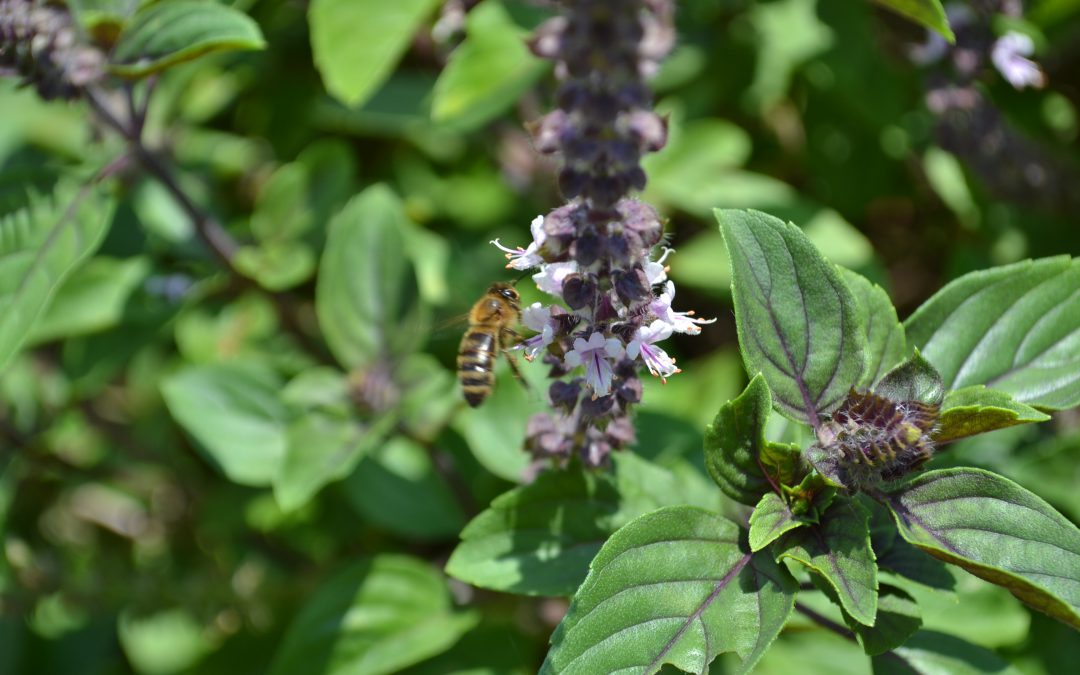
by Beth Bolles | Sep 30, 2021
We hope that you enjoyed the live Q&A with the University of Florida Extension Agent Evan Anderson and Research Coordinator Chris Oster of the UF Honey bee Research and Extension Lab. Below are the questions with the publication links that were provided during the discussion.
What is the best way to get started with a 0.25 acre, residential yard?
How to keep the bee colony in the winter?
How much room should I have for a couple small hives? How many hives should I start with…3?
How much time is involved in the care of the bees and their hive?
Is there a small hive available for a tiny back yard?
What equipment is needed to get started?
Does placing bee hives a certain minimum distance apart help to reduce honey bee colony mortality?
Does Dr. Leo Sharashkin’s Russian concept of horizontal hives fit the environment of the Florida Panhandle?
What is the best treatment for varroa mites?
Identifying behaviors displayed, in order to split the hive. Best time to add supers?
What are good plants for honey bees?
I live near farm fields that use commercial pesticides, can I still bee keep? What are the concerns and how do I mitigate them?
As a first year beekeeper, does all of the rain we’ve experienced this year create any problems that I should be looking for?
Should we be worried about the Asian Giant Hornets in the Florida Panhandle?
We have identified honey bees, cutter bees and carpenter bees in our garden. Should we provide a bee house?
Any killer bees in the area?











